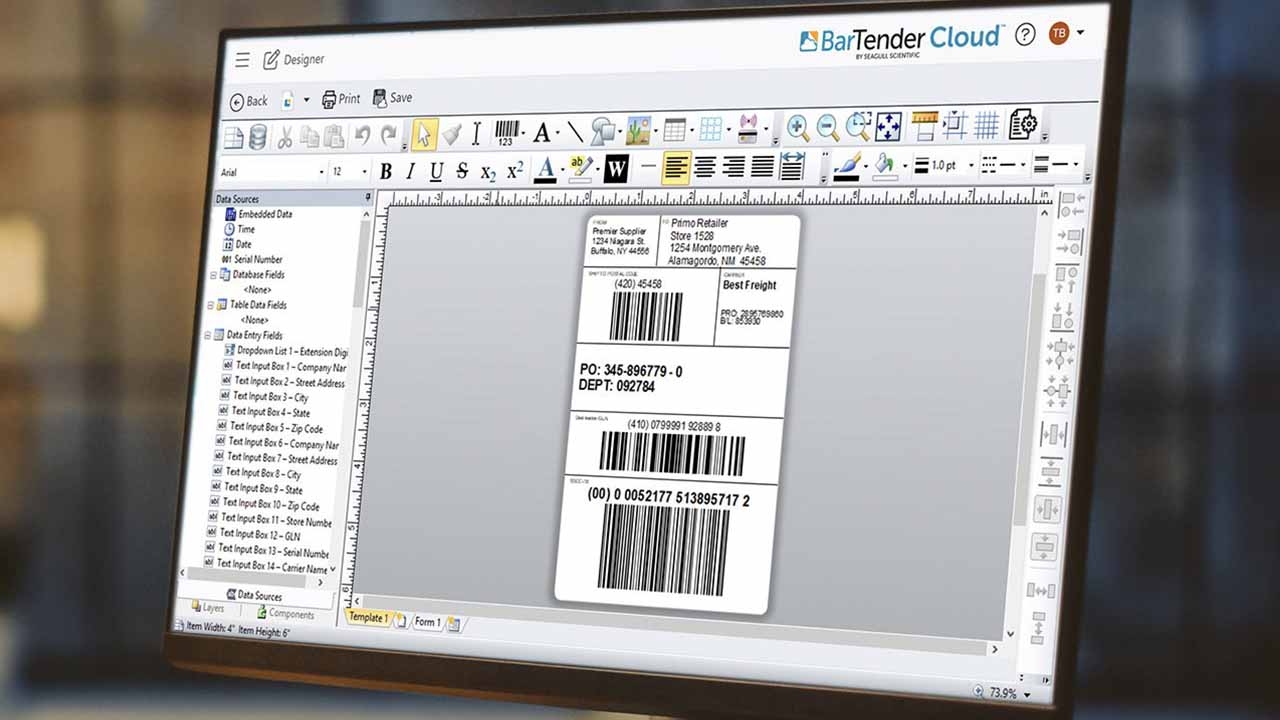
BarTender by Seagull Scientific: Complete Buyer's Guide
Enterprise-grade compliance automation platform
BarTender by Seagull Scientific positions itself as the enterprise-grade compliance automation platform that transforms complex labeling workflows into streamlined, regulatory-compliant operations for manufacturing and logistics organizations.
Market Position & Maturity
Market Standing
BarTender by Seagull Scientific demonstrates exceptional market maturity with over 30 years in the labeling software market, positioning it as one of the most established players in enterprise labeling automation[49][53].
Company Maturity
The platform's 30+ years of continuous operation and extensive global deployment suggest strong business fundamentals and market staying power[49].
Growth Trajectory
Vendor-reported deployment across 250,000+ companies globally represents substantial market penetration, indicating proven scalability and enterprise adoption patterns[50].
Industry Recognition
BarTender differentiates through deep ERP integrations and regulatory compliance automation, capabilities that pure generative AI tools lack[49][53].
Strategic Partnerships
The platform delivers deep ERP integrations with Microsoft Dynamics 365 Supply Chain Management through REST API connectivity, enabling automated label printing workflows[51].
Longevity Assessment
The platform's established customer base, proven ERP integrations, and regulatory expertise suggest strong long-term viability for compliance-focused use cases.
Proof of Capabilities
Customer Evidence
Yaskawa's implementation provides concrete evidence of BarTender's enterprise capabilities, managing 5,000+ label formats through centralized template management with 30% reduction in label administration costs[57].
Quantified Outcomes
Yaskawa's documented 30% reduction in label administration costs provides concrete ROI validation, achieved through automated GTIN-14 generation and centralized template management[57].
Case Study Analysis
ROBAR's pharmaceutical implementation showcases BarTender's strength in regulated environments, where the platform automated label workflows by merging variable data (lot numbers, expiration dates) with approved templates while generating audit trails for FDA 21 CFR Part 11 compliance[55][56].
Market Validation
The 250,000+ global company deployments indicate broad market acceptance, though customer retention rates, satisfaction metrics, and competitive win/loss data remain undisclosed in available research[50].
Competitive Wins
Lubrizol eliminated pre-printed labels using conditional printing, with vendor claims of 15–30% annual cost reductions[56].
Reference Customers
ROBAR's pharmaceutical implementation demonstrates the platform's capability to meet stringent regulatory requirements while maintaining operational efficiency.
AI Technology
BarTender's technology foundation centers on business process automation rather than machine learning or generative AI technologies.
Architecture
The platform delivers deep ERP integrations with Microsoft Dynamics 365 Supply Chain Management through REST API connectivity, enabling automated label printing workflows[51].
Primary Competitors
Pure generative AI platforms may add compliance features over time, potentially eroding BarTender's differentiation.
Competitive Advantages
BarTender differentiates through deep ERP integrations and regulatory compliance automation, capabilities that pure generative AI tools lack[49][53].
Market Positioning
Unlike specialized design tools focused on creative generation, BarTender combines barcode/RFID encoding with compliance automation for industrial applications[51][45].
Win/Loss Scenarios
Choose BarTender when compliance automation and ERP integration outweigh generative design requirements. The platform wins in regulated industries (pharmaceutical, manufacturing, food safety) with existing ERP systems requiring automated compliance management[51][57].
Key Features

Pros & Cons
Use Cases
Integrations
Pricing
Featured In Articles
Comprehensive analysis of AI Product Label Creators for AI Design for AI Design professionals. Expert evaluation of features, pricing, and implementation.
How We Researched This Guide
About This Guide: This comprehensive analysis is based on extensive competitive intelligence and real-world implementation data from leading AI vendors. StayModern updates this guide quarterly to reflect market developments and vendor performance changes.
57+ verified sources per analysis including official documentation, customer reviews, analyst reports, and industry publications.
- • Vendor documentation & whitepapers
- • Customer testimonials & case studies
- • Third-party analyst assessments
- • Industry benchmarking reports
Standardized assessment framework across 8 key dimensions for objective comparison.
- • Technology capabilities & architecture
- • Market position & customer evidence
- • Implementation experience & support
- • Pricing value & competitive position
Research is refreshed every 90 days to capture market changes and new vendor capabilities.
- • New product releases & features
- • Market positioning changes
- • Customer feedback integration
- • Competitive landscape shifts
Every claim is source-linked with direct citations to original materials for verification.
- • Clickable citation links
- • Original source attribution
- • Date stamps for currency
- • Quality score validation
Analysis follows systematic research protocols with consistent evaluation frameworks.
- • Standardized assessment criteria
- • Multi-source verification process
- • Consistent evaluation methodology
- • Quality assurance protocols
Buyer-focused analysis with transparent methodology and factual accuracy commitment.
- • Objective comparative analysis
- • Transparent research methodology
- • Factual accuracy commitment
- • Continuous quality improvement
Quality Commitment: If you find any inaccuracies in our analysis on this page, please contact us at research@staymodern.ai. We're committed to maintaining the highest standards of research integrity and will investigate and correct any issues promptly.